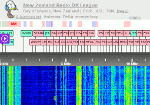Following numerous favourable reviews of the above unit, I was very keen to lay my hands on one and when fellow NZ DXer Steven Greenyer purchased one, I rang him to see what his opinion was. Steven was very pleased with the possibilities the unit offered and his recommendation was enough for me… now all I had to do was to save a little (more than a little actually!) and I figured it would be a late Xmas present to myself. However, Steven rang to tell me there was one available from a deceased ham’s estate, and it took me no more than a couple of seconds to make up my mind! Many thanks to Steven for thinking of me (and to Arthur Williams for tracking it down in the first place!).
US DXer Mark Connelly, had used one extensively and suggested several modifications so after some another ‘phone call to Steven and some initial fiddling with the componentry, I set it up at home and was pleased with some of the results I could obtain using relatively short wires, i.e. one 25 metre horizontal and a 6.5 metre vertical. I could phase out semi-local 4XO 1206 just 100km away to reveal Fiji and make a significant hole in local Radio Waitaki 1395 allowing clear reception of NZers on 1386 and 1404 – with the phaser off they were both splashed into oblivion! I was very keen to get to my Beverage site at Waianakarua and see how it performed with longer wires and the opportunity came over our Labour Weekend holiday.
When I arrived and set up the gear, I was almost in too much of a hurry to connect up the phaser but quickly realised that I had all the cables etc to hook it up – that turned out to be a great idea! Now, I bought this thing to phase out pests and even after Steven told me it was great for enhancing signals by adding the signals from the two aerials required (in this case two 310 metre Beverages, aimed at Florida, one terminated and one unterminated), I didn’t know how good I it was for enhancing signals until I tuned in KCJJ 1630 and decided to use the phaser to try and remove the CW from the Ohura aero beacon on the same frequency. As soon as I switched the phaser on, and before I thought about phasing out the beacon, I gained an immediate lift in signal and the fact that both wires were directional towards the USA, meant that I didn’t need to phase the beacon as the resultant aerial bearing was in the right direction for the desired station, and about 60 degrees off the pest.
So once KCJJ was firmly in the bag, it was time to experiment! Over and over again I was amazed at how I could deal to a pest and clean up co and side-band channels. I was initially sceptical at how well it would work on skywave signals as past experience with the R-L-C type of phasers had shown they worked well on groundwave but not too hot on the former because of signal variation… to sum up just how well it worked on skywave, not only was I able to get significant nulls on almost every NZer tried, I was able to phase out KCCN 1420 in Hawaii and hear a mainland US station running sports talk!
To sum up, If you’re a serious MW DXer, have access to long wires or Beverages and have contemplated buying something to give you an edge (maybe even a new receiver), you have just got to have one of these!
Note: the modifications are necessary though anyone with some experience with a soldering iron would find it relatively easy. Also, there are two models, the MFJ-1025 and 1026, difference being that the 1026 comes with an active whip input which is probably not necessary, my recommendation would be to save yourself a few dollars and get the MFJ-1025. The latter is also easier to modify than the 1026 as it has standard discrete components rather than the surface-mounted variety used in it’s “big brother”.
Lastly, a big “thank you” to Mark Connelly for making the modifications public and encouraging MW DXers to get into this unit. Anyone wanting details of these mods could contact me or check out Mark’s data at the Nordic DX section on Hard Core DX’s web-site.
USING THE PHASER
- Set Auxiliary Gain (AG) fully clock-wise (CW) and the Main Gain (MG) fully anti-clock-wise (ACW) and take note of the signal level.
- Set the AG fully ACW and the MG fully CW and take note of the signal level
- If the reading was lower with the MG fully CW, temporarily set it ACW and set AG to the reading you had with MG, then set the MG back to fully CW, or on the other hand, if the S-meter reading had been lower with AG fully CW (rather than the MG that way), set AG fully ACW and set MG to get the reading you had with maximum AG, then put the AG back to fully ACW
- Rotate the Phase Control for look for a null. If the null isn’t obvious, or if it tends to be at either end of the Phase Control’s range, try the opposite position of the Phase Normal/Invert switch and rotate the Phase Control again to search for a null.
- If a null isn’t achievable, try the opposite position of the Swap Switch and repeat the above step.
- Once the correct combination of Phase Control, Normal/Invert and Swap Switch has been arrived at, make small interactive adjustments of the non-fully clockwise gain control and the Phase Control until the deepest possible null has been acquired.



